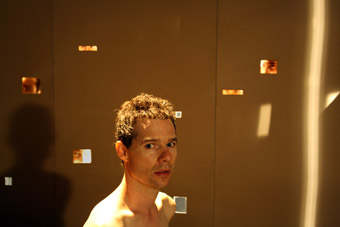the voyeur unsheltered
douglas leonard: clare dyson, the voyeur

Jonathan Sinatra, The Voyeur
photo Rachael Parson
Jonathan Sinatra, The Voyeur
CLARE DYSON’S WORK HAS ALWAYS STRUCK A BRIGHT NOTE ON BRISBANE’S INDEPENDENT DANCE SCENE, BUT SHE HAS BEEN ELUSIVE AND DIFFICULT TO PIN DOWN BECAUSE HER RESTLESS UNDERTAKINGS HAVE TAKEN WIDELY DIFFERENT FORMS. IF ANYTHING, DYSON’S HIGHLY IDIOSYNCRATIC APPROACH MIGHT BE LIKENED TO A CUBIST PAINTER ANALYSING THE SURFACE APPEARANCE OF THINGS.
Nevertheless, there is a definite ‘Dyson-effect’, a sympathetic vibration that travels with us back into daily life but isn’t attributable to any consistent aesthetic element. Instead, there’s always been what I’ll call a ‘community’ of effects distilled into Dyson’s distinctive emotional tone.
Dyson’s latest offering, The Voyeur, is part of a larger doctoral research project looking at how audiences engage with contemporary dance. As such, it lightly carries scholarly references to 1970s performance art, or the even earlier experimental theatre of Polish director Jerzy Grotowski. Like Grotowski’s ‘holy’ theatre, Dyson’s audience is limited in size and configured as a vital part of the performance. Bruce McKinven’s design consists of a room constructed from heavy ply on the bare stage at QUT Gardens Theatre. The audience is given the choice of watching through multiple peepholes that provide access to a more or less partial view of the performance. They can listen through headphones to either one of the nakedly confessional texts produced by the two performers, but not both.
The room reflects a student bohemia from the past, indicated by a record collection and an old style gramaphone. The action is nostalgic, reminiscent of evenings we all remember when we resorted to playing our favourite records in an attempt to be understood by ‘the Other’, significant or otherwise. Records chosen ranged from Harry Belafonte to Iggy Pop, and Phillip Glass’s retrospective collection Glassworks. Two ‘lovers’ face one another, intimately looking into each other’s eyes. They are smiling tenderly, but knowingly, for there is danger here as well as promise.
Whole worlds might be exchanged in such encounters, but there is always the possibility of violation in one’s depths. The two play a game of slapping and sparring, testing the waters until, apparently unable to sustain the nakedness and vulnerability inherent in each other’s gaze, they break away, each to their own self-contained world. This was the leitmotif for the performance, and duplicated our own atomised responses as an audience of voyeurs individually consigned to play out a perversely ritualised, collective role. Shuffling, bending, peering through monoculars, we paid no heed to each other, even avoided each other’s eyes. Particularly we ducked the gaze of watchers concealed behind opposite walls lest we find ourselves in the position of the voyeur in Barbusse’s L’Enfer who peers through a keyhole only to be shocked to meet another eye staring back.
The more urgently, the more desirously we sought to become intimate with the performers, to enter their private worlds or perhaps simply to make the disparate elements of the performance cohere, the more we were forced to acknowledge our own gaze mirrored in their presence, to find that it was the recalled intimacies in our own lives that we must confess, the raw nature of our own desires that really counted. Dyson tells us through the headphones that research shows it takes the average audience member 15 minutes to fantasise about what it would be like to have an intimate relationship with the performer. She lethally evokes and simultaneously mocks desire as she slowly slices through a passion fruit on her bared thigh. As the juices run and her eyes seek us out, she obligingly personifies the object of desire. That the moment is bracketed, however, points to the performer as emptied of all real characteristics and substance. She is fulfilling a symbolic function, reflecting back the projection of our own narcissism. If you had been on her ‘track’, you were both aroused and at the same time felt completely exposed. Exposed in the sense of Lear and the Fool on the heath in the middle of a storm: that is to say, without shelter.
Dyson cites philosopher Emmamual Levinas to the effect that an encounter with ‘the Other’ is the only way of revealing the truth about ourselves. The interacting subjectivities of the performers—through what I would describe as the naked effrontery (in the sense of a scandal) of their texts, and in movement that comfortably existed in the here and now, in this time spot (however past)—showed us that unsheltering in Levinas’s sense can become a homecoming and a healing. This was ambiguously spoken for in Dyson’s Magdalene-like action of washing Sinatra’s hair, and in Sinatra’s self-absorbed jouissance in a dance to Iggy Pop’s Lust for Life while she sweeps the floor, but could only truly, finally be mediated, in Dyson’s wonderful dispensation, her gift to us, by the despicable voyeur, her audience.
The Voyeur, creator Clare Dyson, choreography, performance, text Clare Dyson, Jonathan Sinatra, dramaturg Kathry Kelly, lighting design Mark Dyson, design Bruce McInven, QUT Gardens Theatre, Brisbane, Nov 22-25, 2009
RealTime issue #95 Feb-March 2010 pg. 35






